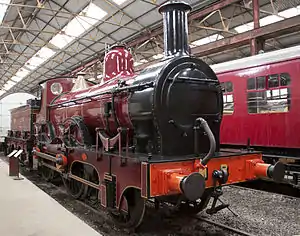Midland Railway 156 Class
The Midland Railway 156 Class was a class of 2-4-0 tender engines built at Derby Works between 1866 and 1874. In total 29 of the class were built under the Midland Railway. They were rebuilt sometime between 1873 and 1903.[1]
| Midland Railway 156 Class | |||||||||||||||||||||
|---|---|---|---|---|---|---|---|---|---|---|---|---|---|---|---|---|---|---|---|---|---|
 MR 158A, the oldest surviving Midland Railway locomotive | |||||||||||||||||||||
| |||||||||||||||||||||
| |||||||||||||||||||||
| |||||||||||||||||||||
| |||||||||||||||||||||
History
These engines used to work on express passenger trains to King's Cross, which was then the Midland Railway's London Terminus.[2] 21 survived to become part of the London, Midland and Scottish Railway (LMS) fleet of engines in 1923. By then they were reduced to the humblest of roles. In September 1930, the LMS recognised the significance of the class and number 156 itself was ear-marked for preservation. But William Stanier chose not to preserve it and the engine was scrapped two years later.[3][4]
Preservation
One engine, 158A (originally built as 158 before subsequently renumbered to that number, then it became Midland Railway's No. 2 in 1907, and finally 20002 by the LMS in 1934) survives. She was withdrawn from service in July 1947 as a station pilot at Nottingham station by the LMS to be restored to her former Midland identity and old number 158A as a static exhibit in Birmingham during the centenary celebrations at the New Street station in 1954.[5][6]
The locomotive was preserved at Derby Works until being moved to the National Railway Museum. She was on loan to the Midland Railway – Butterley in Butterley, Derbyshire and was still on static display since 1975.[7] The surviving example is not in as built condition. It has twice been reboilered and the front end rebuilt. The original tender was replaced a century ago. The tender that is now attached to 158A is the tender from Midland Railway 700 Class No. 2846.[8]
References
- Baxter 1982, pp. 62–66.
- Websites, Steve Morris (SJM. "158A". Retrieved 5 January 2017.
- "Castle Bromwich Station: Ex-Midland Railway 1P 2-4-0 No 1 stands at the up platform on a Birmingham to Derby local train on 3rd June 1925". Warwickshire Railways. Retrieved 5 January 2017.
- "Kings Norton Locomotives: Ex-MR outside-framed 2-4-0 No 1 is seen on a local passenger train to Birmingham New Street". Warwickshire Railways. Retrieved 5 January 2017.
- "Kings Heath Station - Ex-Midland Railway outside curved frame Kirtley 2-4-0 No 20002 is seen leaving Kings Heath for Camp Hill". Warwickshire Railways. Retrieved 5 January 2017.
- "Bournville Shed - LMSR 1P 2-4-0 No 20002 photographed outside the shed at Bournville on Saturday 2nd March 1935". Retrieved 5 January 2017.
- "Midland Railway No. 158A, Butterley, June 1976". Retrieved 5 January 2017.
- D Sharpe, The Railways of Cadbury and Bourneville, Bournbrook Publications, 2002. Page 66
- Baxter, Bertram (1982). Baxter, David (ed.). British Locomotive Catalogue 1825–1923. Volume 3A: Midland Railway and its constituent companies. Ashbourne, Derbyshire: Moorland Publishing Company. ISBN 9780903485524.